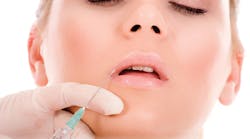Training for facial injections expand the skill set for dental hygienists
By Hannah Fox, RDH, BS, and Paige Ernst, BS, RDH
Facial injections have recently found a niche in the field of dentistry. Botulinum toxin type A and hyaluronic acid gel injections are an additional service dental offices are beginning to provide to their patients while in the dental chair. These agents can aid in the treatment of dental complications (e.g., temporomandibular joint disorder) or they may also be used for cosmetic purposes (e.g., the treatment of fine lines and wrinkles). The latter is what facial injections are most known for. Dental hygienists have the opportunity to become certified to administer facial injections, depending upon specific state regulations, to meet the cosmetic needs of the patient and to generate additional income for dental practices. Before becoming certified, hygienists must complete 12-18 months of additional schooling to become an LPN.
Drug overview-Botulinum toxin type A is a drug made from a toxin produced by the bacterium Clostridium botulinum. This drug works by weakening or paralyzing certain muscles or by blocking the conduction of certain nerves.1 Furthermore, botulinum toxin type A inhibits the exocytosis of acetylcholine on cholinergic nerve endings of motor nerves, which, in turn, relaxes the facial muscles.2
Another drug used for facial injections is hyaluronic acid gel. This drug is a naturally occurring chemical in the body and is not derived from animal sources.3 The gel works by inflating to improve tissues that have lost volume or elasticity in the perioral cavity and acts as a network that transfers essential nutrients from the bloodstream to skin cells.3 One major benefit of this product is its low allergic potential since it is found naturally in the body.3
Uses in dentistry-In dentistry, botulinum toxin type A is used for the management of dental complications including temporomandibular joint disorder, bruxism, clenching, and masseter hypertrophy. Additionally, it is used in dentistry to treat cosmetic complications such as deep nasolabial folds, radial lip lines, and a high lip line.5 Hyaluronic acid gel aids in the rejuvenation of facial tissue by reducing or eliminating wrinkles, raising scar depressions, and replacing soft-tissue volume loss.2 The clinical uses include treating fine lines and nasolabial folds, enhancing lips, contouring of the facial tissue, improving the appearance of recessed scars, and enhancing the volume of gingival tissue interproximally to avoid black triangles between teeth.3
Safety-Like any type of injection, side effects may be present after administration. Adverse effects of hyaluronic acid gel include swelling, tenderness, pain, and bruising at the injection site.3 The adverse effects of botulinum toxin type A may include facial nerve palsy, pain at the injection site, flulike symptoms, nontargeted muscle weakness, dysphasia, and hematoma.8 Likewise, facial injections also have contraindications. The contraindications to hyaluronic acid gel include active infection near the site of injection and a known allergy or hypersensitivity to the material in hyaluronic acid or to the lidocaine mixed in the syringe.9 Additionally, the filler should not be injected in areas that lack sufficient blood supply.9 The contraindications of botulinum toxin type A include pregnancy, lactation, neuromuscular diseases, motor neuron diseases, concurrent uses of amino glycosides, and sensitivity to toxin.8
Statistics-From 2012-2013, minimally invasive cosmetic procedures, including botulinum toxin type A and hyaluronic acid gel injections, increased by 3%. In 2013, 13.4 million minimally invasive procedures were completed. Additionally, the top two minimally invasive procedures in 2013 were botulinum toxin type A (6.3 million) and soft-tissue fillers (2.2 million).6 Although these facial injections are prevalent in other health-care fields, only approximately 7-8% of dental offices in North America provide facial injections.10
Education-Health professionals licensed to administer botulinum toxin type A and hyaluronic acid gel injections after certification include licensed practical nurses (LPN), dentists (DDS or DMD), registered nurses (RN), medical doctors (MD), doctors of optometry (DO), nurse practitioners (NP), and physician assistants (PA). After receiving a degree in any of these fields of study, the health professionals listed above must participate in an additional one full day of training for botulinum toxin type A and hyaluronic acid gel injections, which includes classwork and a lab session, or weekend training sessions. The average cost of this additional course is approximately $1,500-$2,000.7
Additionally, as a registered or licensed dental hygienist, further education must be completed in order to be certified to administer botulinum toxin type A and hyaluronic acid gel facial injections. Before completing the certification course, a dental hygienist has to complete an additional 12-18 months of education to become a licensed practical nurse. After completing the necessary degree, passing the National Council Licensure Examination for Practical Nurses (NCLEX-PN) is required.
Dentists interested in sending dental hygienists back for further education to become LPNs may choose to invest in the costs of the additional schooling in order to generate more revenue for the dental office. Just as with other health professionals, after receiving a degree as an LPN, an additional one full day or full weekend of training on botulinum toxin type A and hyaluronic acid gel injections, including a lab session and classwork, is mandatory.
It is important to note that permission to administer botulinum toxin type A and dermal fillers in a dental office depends upon each state's dental practice act and decision of the state's dental board.6
Integration into practice
After completing the required educational components, dental professionals, including dental hygienists, may become certified to administer these injections in the oral and maxillofacial areas only. Other licensed medical professionals can be certified to administer facial injections; these professionals may be employed by dental offices to provide these services. As previously mentioned, dentists may send dental hygienists back for further education to become licensed to administer facial injections and they may choose to invest in the costs of the additional schooling in order to generate more revenue for the dental office. Dental hygienists may also choose to further their education in order to become more marketable in the field of dentistry.
Botulinum toxin type A and hyaluronic acid gel injections have recently become more popular in private practice dental offices. These facial injections aid in the management of muscle-generated deterioration and may be used to treat functional and esthetic dental conditions. Currently, facial injections are minimally used in the field of dentistry for esthetic purposes, but as soft-tissue injections become more popular, it is hoped that they will be utilized for a broadened spectrum of services related to the oral and maxillofacial areas, such as in the treatment of functional disorders. Dental hygienists should consider the value of their role in the delivery of these services and seek further education.
Authors' note: We would like to express our gratitude to Angie Bowlds, who devoted her time and expertise during our research of this topic. RDH
Financial impact of services on a dental practice
Adding these services to an established practice may enhance revenue. On average, the administration of botulinum toxin type A costs approximately $12 per unit, with each injection requiring two to four units of the drug. Hyaluronic acid gel costs $500 per cartridge on average. Depending upon the area or areas being treated, more than one syringe of hyaluronic acid gel or between five to 10 units of botulinum toxin type A may be required for desired results.7
The maintenance for administration varies from person to person, with every six months being the average time frame between injections.7 Likewise, the typical recall appointment for most hygiene patients is approximately every six months.
Therefore, it is interesting to note that patients may receive their facial injections during their routine dental hygiene treatment appointment. If patients receive both treatments during the same appointment, additional time may need to be added to the appointment; however, the practice is acquiring more revenue in a short window of time.
Hannah Fox, RDH, is a recent graduate of the dental hygiene program at the University of Southern Indiana. She lives in the Evansville, Indiana, area and is continuing her education to become a dentist. Paige Ernst, RDH, is a recent graduate of the dental hygiene program at the University of Southern Indiana. She recently returned to her hometown of Bloomington, Indiana, and began her career as a dental hygienist at a general family practice office.
References
1. Botox. U.S. National Library of Medicine: Medline Plus. https://www.nlm.nih.gov/medlineplus/botox.html. Updated April 19, 2016. Accessed October 1, 2015.
2. Jain M, Bansal A, Agarwal D, Joshi M. Botox in dentistry: The healing side of a poison. J Adv Med Dent Scie. 2014:2(1):95-99.
3. Dermal fillers: Hyaluronic acid. American Society of Plastic Surgeons website. http://www.plasticsurgery.org/cosmetic-procedures/dermal-fillers-hyaluronic-acid.html. Accessed February 5, 2015.
4. Restylane. American Academy of Facial Esthetics website. http://www.facialesthetics.org/patient-info/facial-esthetics/wrinkle-treatment/restylane/. Accessed October 1, 2015.
5. Nayyar P, Kumar P, Nayyar PV, Singh A. Botox: Broadening the horizon of dentistry. J Clin Diagn Res. 2014;8(12):ZE25-29.
6. Clinician's Corner: A discussion about dermal fillers, Botox and dentistry. ADA Professional Product Review. 2015;10(3):4-9.
7. Ernst P, Fox H, Bowlds A. Interview on facial injections given by a dental hygienist in a dental practice [student paper]. 2015.
8. Rao LB, Sanqur R, Pradeep S. Application of botulinum toxin type A: An arsenal in dentistry. Indian J Dent Res. 2011;22(3) 440-445.
9. Lafaille P, Benedetto A. Fillers: Contraindications, side effects and precautions. J Cutan Aesthet Surg. 2010;3(1):16-19.
10. Botox. American Academy of Facial Esthetics website. https://www.facialesthetics.org/patient-info/facial-esthetics/wrinkle-treatment/botox/. Accessed October 18, 2015.
11. Licensed Practical Nurse/Licensed Vocational Nurse (LPN/LVN). RNtoBSN website. http://www.rntobsn.org/careers/lpn-lvn/. Accessed February 22, 2016.







